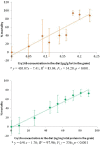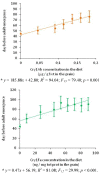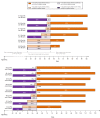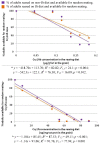Effects of two varieties of Bacillus thuringiensis maize on the biology of Plodia interpunctella
- PMID: 22778907
- PMCID: PMC3386637
- DOI: 10.3390/toxins4050373
Effects of two varieties of Bacillus thuringiensis maize on the biology of Plodia interpunctella
Abstract
On the market since 1996, genetically modified plants expressing an insecticidal toxin (Cry toxin stemmed from Bacillus thuringiensis) target several lepidopteran and coleopteran pests. In this study, we assessed the impact of two varieties of Bt maize producing different toxins (Cry1Ab or Cry1Fa, respectively) on the biology of a storage pest: Plodia interpunctella (Hübner) (Lepidoptera: Pyralidae). The Indianmeal moths were susceptible to both toxins but showed an escape behavior only from Cry1Fa. The weight of females issued from larvae reared on Cry1Ab increased with increasing toxin concentration, but adults of both sexes reared on Cry1Fa had decreased weight. Both toxins increased development time from egg to adult regardless of sex and had no impact on the male adult lifespan. Finally, we recorded a time lag between metamorphosis from the non-Bt and the Bt diets, which increased proportionally to Cry concentration in the Bt diet.
Keywords: Bt maize; Plodia interpunctella; biological parameters; cry toxin.
Figures




Similar articles
-
Populations of Helicoverpa zea (Boddie) in the Southeastern United States are Commonly Resistant to Cry1Ab, but Still Susceptible to Vip3Aa20 Expressed in MIR 162 Corn.Toxins (Basel). 2021 Jan 15;13(1):63. doi: 10.3390/toxins13010063. Toxins (Basel). 2021. PMID: 33467562 Free PMC article.
-
Effects of transgenic Bacillus thuringiensis maize grain on B. thuringiensis-susceptible Plodia interpunctella (Lepidoptera: Pyralidae).J Econ Entomol. 2000 Jun;93(3):1011-6. doi: 10.1603/0022-0493-93.3.1011. J Econ Entomol. 2000. PMID: 10902364
-
Introgression of a cry1Ab transgene into open pollinated maize and its effect on Cry protein concentration and target pest survival.PLoS One. 2019 Dec 16;14(12):e0226476. doi: 10.1371/journal.pone.0226476. eCollection 2019. PLoS One. 2019. PMID: 31841532 Free PMC article.
-
Insecticidal Activity of Bacillus thuringiensis Proteins Against Coleopteran Pests.Toxins (Basel). 2020 Jun 29;12(7):430. doi: 10.3390/toxins12070430. Toxins (Basel). 2020. PMID: 32610662 Free PMC article. Review.
-
Bt maize and integrated pest management--a European perspective.Pest Manag Sci. 2011 Sep;67(9):1049-58. doi: 10.1002/ps.2221. Epub 2011 Jun 27. Pest Manag Sci. 2011. PMID: 21710684 Review.
Cited by
-
Sub-lethal effects of Vip3A toxin on survival, development and fecundity of Heliothis virescens and Plutella xylostella.Ecotoxicology. 2015 Nov;24(9):1815-22. doi: 10.1007/s10646-015-1517-6. Epub 2015 Jul 11. Ecotoxicology. 2015. PMID: 26162322
-
Genomics and Proteomics Analyses Revealed Novel Candidate Pesticidal Proteins in a Lepidopteran-Toxic Bacillus thuringiensis Strain.Toxins (Basel). 2020 Oct 26;12(11):673. doi: 10.3390/toxins12110673. Toxins (Basel). 2020. PMID: 33114565 Free PMC article.
-
Lengthening of insect development on Bt zone results in adult emergence asynchrony: does it influence the effectiveness of the high dose/refuge zone strategy?Toxins (Basel). 2012 Nov 15;4(11):1323-42. doi: 10.3390/toxins4111323. Toxins (Basel). 2012. PMID: 23202319 Free PMC article.
-
Effectiveness of the high dose/refuge strategy for managing pest resistance to Bacillus thuringiensis (Bt) plants expressing one or two toxins.Toxins (Basel). 2012 Oct;4(10):810-35. doi: 10.3390/toxins4100810. Epub 2012 Oct 18. Toxins (Basel). 2012. PMID: 23162699 Free PMC article.
References
-
- Vaeck M., Reynaerts A., Hofte H., Jansens S., De Beuckeleer M., Dean C., Zabeau M., Montagu M.V., Leemans J. Transgenic plants protected from insect attack. Nature. 1987;328:33–37.
-
- Ferré J., Escriche B., Bel Y., Rie J. Biochemistry and genetics of insect resistance to Bacillus thuringiensis insecticidal crystal proteins. FEMS Microbiol. Lett. 1995;132:1–7.
-
- Alyokhin A., Ferro D. Relative fitness of Colorado potato beetle (Coleoptera:Chrysomelidae) resistant and susceptible to the Bacillus thuringiensis Cry3A toxin. J. Econ. Entomol. 1999;92:510–515.
Publication types
MeSH terms
Substances
LinkOut - more resources
Full Text Sources

